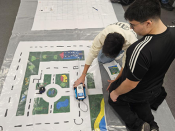Clarisse Magarreiro
IDL
Resumo: Atmospheric models can add value to solar energy applications by enabling solar resource assessments as they easily overcome the limited spatial and temporal coverage of irradiance measuring networks.
Furthermore, climate models can be used for any region of the planet to assess the solar resource for not only present climate conditions but also to analyse its long-term past evolution and future tendency.
Here, a dynamical downscaling approach is used to evaluate simulated solar radiation at the Earth’s surface which will enable the characterization of the solar resource. The model output is also combined with a statistical downscaling approach used in its simplest form to minimize the model biases. These methods are used to characterize the present climate renewable solar resource and analyse the impact of climate change on its projections for the end of the 21st century for Iberia Peninsula and Azores archipelago.
Since atmospheric numerical models only provide global solar radiation the separation of global radiation into its diffuse and direct components through models of diffuse solar radiation fraction is also discussed.


















